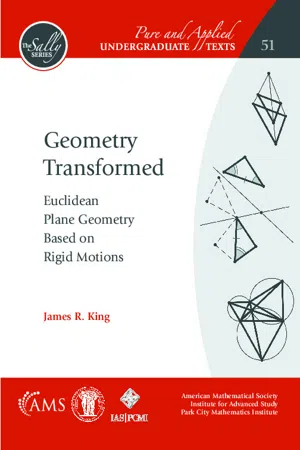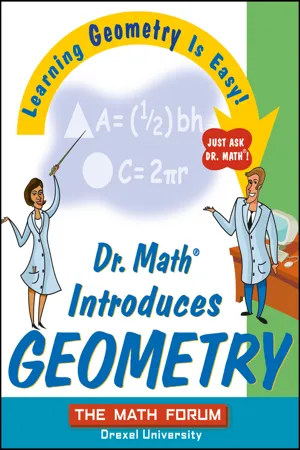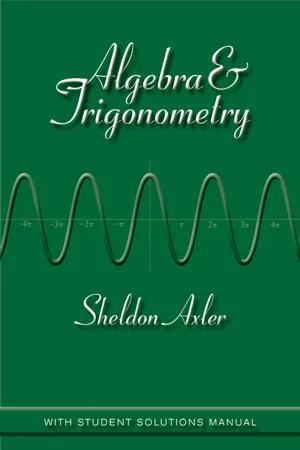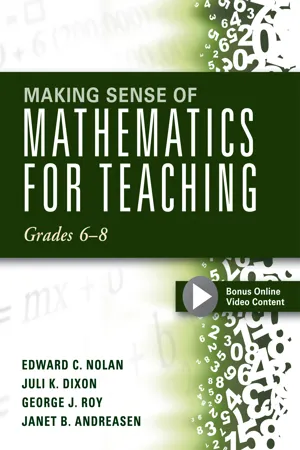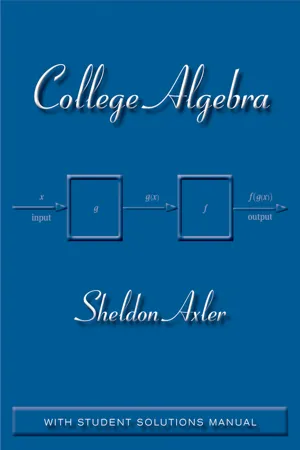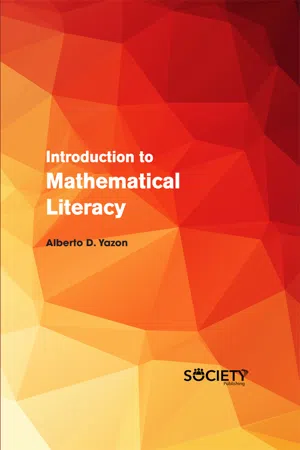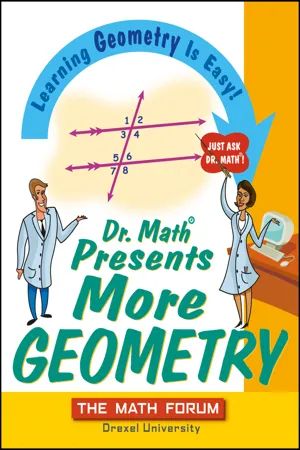Mathematics
Area of Parallelograms
The area of a parallelogram is the measure of the space enclosed within its boundaries. It is calculated by multiplying the base of the parallelogram by its height. The formula for finding the area of a parallelogram is A = base × height, where A represents the area.
Written by Perlego with AI-assistance
Related key terms
1 of 5
12 Key excerpts on "Area of Parallelograms"
- eBook - PDF
Geometry Transformed
Euclidean Plane Geometry Based on Rigid Motions
- James R. King(Author)
- 2021(Publication Date)
- American Mathematical Society(Publisher)
Chapter 9 Area and Its Applications Areas of Triangles and Parallelograms Area, a familiar and useful topic in the real world, is not only an interesting topic in geometry; it also provides an additional tool for understanding geometrical relation-ships. While it is simple in some respects, it is not so simple in others. The simple part includes the familiar formulas for areas of rectangles, triangles, parallelograms, and other basic polygons. The not-so-simple part is expressing a general definition of area and then proving it agrees with the simple formulas but also applies to shapes such as circles and other nonpolygonal shapes. To derive an area formula for circles, limits are involved. This is as far as we will be going in this book. 1 Area should have these properties: • Congruent figures have the same area. • For a square ? of side length 1, the area 𝒜(?) = 1 . • If the set ? 1 contains ? 2 , then 𝒜(? 1 ) ≥ 𝒜(? 2 ) . • If a set ? is the union of a finite number ? 1 , ? 2 , ... , ? 𝑘 of convex polygons and their interiors such that the polygon interiors do not intersect, then 𝒜(?) = 𝒜(? 1 ) + 𝒜(? 2 ) + ⋯ + 𝒜(? 𝑘 ). Squares and the Definition of Area. All our work with area will rely on the areas of squares. Consider how only one definition makes sense. A square of integer side 𝑚 can be divided into 𝑚 2 unit squares of side 1, so the area should be 𝑚 2 . For example, the square on the left of Figure 1 is 9, assuming the small squares have side 1. If the area of a square of side 1 is divided into squares of side length 1/𝑛 , then since there are 𝑛 2 such small squares, the area of the small square should be 1/𝑛 2 . The area of 1 If one investigates really complicated sets in the plane, such as fractals, it turns out that a set may have no area, or it may have more than one value competing to be area. 161 - eBook - PDF
Dr. Math Introduces Geometry
Learning Geometry is Easy! Just ask Dr. Math!
- (Author)
- 2004(Publication Date)
- Jossey-Bass(Publisher)
For rectangles and squares, these are the same, but they’re different for most parallelograms. Here is a diagram of your parallelogram: What you should have done is this: The base is 27 yards. I assume that when you say “12 yards inside the parallelogram,” you mean the height—the length of a line joining the top and bottom that is perpendicular (at right angles) to both of them. Then using the formula area of a parallelogram = base ⋅ height = 27 yd ⋅ 12 yd = 324 yd 2 Don’t forget that area is measured in square units, like square yards (yd 2 ), not just yards! So once again, these are the main things to remember: 1. Use the right formula for the figure—know the definitions of parallelogram, trapezoid, and other shapes. 74 Dr. Math Introduces Geometry 2. Know the definitions of the terms used in the formulas (base, height, etc.) so that you use the right number for each. And one more thing related to the second item: don’t be confused when a figure has more numbers than you need! You didn’t need the length of the short side to figure out the area of the parallelogram; that is only needed for the perimeter (unless you’re using it to figure out the height, but that’s another problem). —Dr. Math, The Math Forum Dear Leon, These are largely just different terms for the same thing, but they are named differently to remind you of some important details. We usually use length and width to describe the dimensions of rectangles. (Most of the time, the longer side is l and the shorter side is w, but it really doesn’t matter as long as you’re consistent within any single problem.) Areas and Perimeters of Two-Dimensional (2-D) Geometric Figures 75 Dear Dr. Math, What is the difference between length times width and base times height? They look the same to me, except the figure being meas- ured is rotated. Why do you use two different formulas to measure a parallelogram and a square? Yours truly, Leon Base or Width? The area is the product of these, whichever way we name them. - eBook - PDF
- Sheldon Axler(Author)
- 2011(Publication Date)
- Wiley(Publisher)
Because the area of the rectangle equals bh, we thus have the following formula for the area of a parallelogram: Area of a parallelogram A parallelogram with base b and height h has area bh. Triangles and Trapezoids To find the area of a triangle, select one of the sides and call its length b h A triangle with base b and height h. the base. The height of the triangle is then defined to be the length of the perpendicular line segment that connects the opposite vertex to the side determining the base, as shown in the figure in the margin. To derive the formula for the area of a triangle with base b and height h, draw two line segments, each parallel to and the same length as one of the sides of the triangle, to form a parallelogram as in the figure below: b h The triangle has been extended to a parallelogram by adjoining a second triangle with the same side lengths as the original triangle. 100 chapter 2 Combining Algebra and Geometry The parallelogram above has base b and height h and hence has area bh. The original triangle has area equal to half the area of the parallelogram. Thus we obtain the following formula: Area of a triangle A triangle with base b and height h has area 1 2 bh. example 1 Find the area of the triangle whose vertices are (1, 0), (9, 0), and (7, 3). solution Choose the side connecting (1, 0) and (9, 0) as the base of this triangle. 1 3 5 7 9 1 3 Thus this triangle has base 9 - 1, which equals 8. The height of this triangle is the length of the red line shown here; this height equals the second coordinate of the vertex (7, 3). In other words, this triangle has height 3. Thus this triangle has area 1 2 · 8 · 3, which equals 12. Consider the special case where our triangle happens to be a right trian- a b A right triangle with area 1 2 ab. gle,with the right angle between sides of length a and b. Choosing b to be the base of the triangle, we see that the height of this triangle equals a. Thus in this case the area of the triangle equals 1 2 ab. - eBook - ePub
Making Sense of Mathematics for Teaching Grades 6-8
(Unifying Topics for an Understanding of Functions, Statistics, and Probability)
- Edward C. Nolan, Juli K. Dixon(Authors)
- 2016(Publication Date)
- Solution Tree Press(Publisher)
What are the dimensions of this new parallelogram? The base of the parallelogram is the sum of the bases of the trapezoid, or b 1 + b 2. The height of the parallelogram is the same as the height of the trapezoid. What is the area of the parallelogram? The area of a parallelogram is the product of its base and associated height, so the area of the parallelogram is A par = (b 1 + b 2) h. How does the area of the parallelogram relate to the area of the trapezoid? The parallelogram is made up of two congruent trapezoids, so the area of one of the trapezoids is equal to one-half the area of the parallelogram. Therefore, A trap = ½(b 1 + b 2) h. This last method is quite efficient in reaching a simplified expression; however, any of these techniques will determine the area formula of a trapezoid. Figure 5.7: Trapezoid decomposed into two triangles. As you considered this task, with which Mathematical Practices were you engaged? One was Mathematical Practice 3, “Construct viable arguments and critique the reasoning of others.” Through the process of examining the area of a trapezoid, various methods resulted in different strategies of how to determine the formula. As you examined your own method and compared it to other methods, you were constructing arguments as to why your method was appropriate. At the same time, you were critiquing the reasoning of others by making sense of the alternate methods and how they might be similar to or different from your method. You also engaged in Mathematical Practice 7, “Look for and make use of structure,” in that you used the structure and properties of shapes to make sense of finding the area of an unknown shape, in this case, a trapezoid. By exploring the geometric structure of the trapezoid, the areas of rectangles, triangles, and parallelograms were used to make sense of the area of a trapezoid. The structure of equations and expressions also supported your viable arguments when you found equivalent expressions - eBook - PDF
- Tom Bassarear, Meg Moss(Authors)
- 2019(Publication Date)
- Cengage Learning EMEA(Publisher)
A. Using the fact that the formula for finding the area of a rectangle (base) (height) 5 3 , cut out a parallelogram out of paper, and turn it into a rectangle without losing or gaining any area. Use this to determine the area of a parallelogram. B. Using the area formula for a parallelogram that you just discovered, find the formula for the area of a triangle. Hint: Cut out two identical triangles, and turn them into a parallelogram. C. Using the area formulas you just discovered, determine the area formula for trape- zoids. There are two ways to do this. One way requires only one trapezoid cut out of paper, and the other way is to cut out two identical trapezoids. DISCUSSION A. Understanding the area formula for parallelograms The formula for determining the area of a parallelogram is connected to the formula for determining the area of a rectangle. The diagram at the right in Figure 9.9 illustrates the connection. Can you see it? How would you explain it? Figure 9.9 height height base base If we cut the triangle from the parallelogram and reconnect it at the right-hand side, we have transformed the parallelogram into a rectangle. We have not added or subtracted any area, so the areas of the parallelogram and the rectangle must be equal. From Figure 9.9, you can see that the base of the parallelogram is congruent to the base of the rectangle and that the height of the parallelogram is congruent to the height of the rectangle. Because we know that the areas of the two are equal, we can now state that the area of any parallelogram is equal to the product of its base and its height; that is, A bh 5 (Figure 9.10). A key aspect here is that the base and the height are perpendicular (they form a right angle). Figure 9.10 base height base height B. Understanding the area formula for triangles Consider triangle MAN (Figure 9.11). - eBook - PDF
- Sheldon Axler(Author)
- 2011(Publication Date)
- Wiley(Publisher)
Because the area of the rectangle equals bh, we thus have the following formula for the area of a parallelogram: Area of a parallelogram A parallelogram with base b and height h has area bh. Triangles and Trapezoids To find the area of a triangle, select one of the sides and call its length b h A triangle with base b and height h. the base. The height of the triangle is then defined to be the length of the perpendicular line segment that connects the opposite vertex to the side determining the base, as shown in the figure in the margin. To derive the formula for the area of a triangle with base b and height h, draw two line segments, each parallel to and the same length as one of the sides of the triangle, to form a parallelogram as in the figure below: b h The triangle has been extended to a parallelogram by adjoining a second triangle with the same side lengths as the original triangle. 100 chapter 2 Combining Algebra and Geometry The parallelogram above has base b and height h and hence has area bh. The original triangle has area equal to half the area of the parallelogram. Thus we obtain the following formula: Area of a triangle A triangle with base b and height h has area 1 2 bh. example 1 Find the area of the triangle whose vertices are (1, 0), (9, 0), and (7, 3). solution Choose the side connecting (1, 0) and (9, 0) as the base of this triangle. 1 3 5 7 9 1 3 Thus this triangle has base 9 - 1, which equals 8. The height of this triangle is the length of the red line shown here; this height equals the second coordinate of the vertex (7, 3). In other words, this triangle has height 3. Thus this triangle has area 1 2 · 8 · 3, which equals 12. Consider the special case where our triangle happens to be a right triangle, a b A right triangle with area 1 2 ab. with the right angle between sides of length a and b. Choosing b to be the base of the triangle, we see that the height of this triangle equals a. Thus in this case the area of the triangle equals 1 2 ab. - eBook - PDF
- Alberto D. Yazon(Author)
- 2019(Publication Date)
- Society Publishing(Publisher)
Perimeter and Area 97 In this way, a regular polygon is a tangential polygon. A regular n-sided polygon can be structured with the help of the compass and straightedge if and only if the odd prime factors of n are distinct Fermat primes. 4.12.1. Area of the Polygon The formula to evaluate the area of a regular polygon can be written as: A = (1/2) × a × P where, P is the perimeter; a is the apothem. 4.13. PARALLELOGRAM FORMULA The parallelogram is a geometrical figure which is consisting of four sides formed with the help of the two pairs of parallel lines. Opposite sides are having the equal length and opposite angles are equal in amount. The base, as well as height of a parallelogram, must be perpendicular with respect to each other. Never the less, the lateral sides of a parallelogram are not perpendicular with respect to the base. In this way, a dotted line is drawn to represent the height. The area of a parallelogram is also equal to the magnitude of the vector cross product of two adjacent sides. The area of a triangle created with the help of one of its diagonals. A picture of a leaning box or rectangle is the best example of a parallelogram. 4.13.1. Perimeter The perimeter is the sum of the length of all the 4 sides. The perimeter of a parallelogram is the total distance outside the geometrical shape. The opposite side of a parallelogram is equal and so the perimeter becomes twice the sum of base and height. The perimeter of a Parallelogram Formula is given as, Perimeter of a Parallelogram= 2 * (Base + Height) 4.13.2. Area Area = b × h In this way, where, b is the length of any base and h is the corresponding altitude or height. Introduction to Mathematical Literacy 98 REFERENCES 1. Art Foundations, (2019). Element of Design Shape . [online] Wcs.k12. mi.us. Available at: http://www.wcs.k12.mi.us/cousino/wcsart/art%20 foundatons%20site/shape.html (Accessed on 17 August 2019). 2. BrainPOP (2019). Perimeter – BrainPOP Jr. . [online] Jr.brainpop.com. - eBook - PDF
Dr. Math Presents More Geometry
Learning Geometry is Easy! Just Ask Dr. Math
- (Author)
- 2005(Publication Date)
- Jossey-Bass(Publisher)
Note that when a = b, a + b = b + b ____ _____ 2 2 = 2 ⋅ b ____ 2 = b If we make all the angles square, we have a rectangle: 120 Dr. Math Presents More Geometry b a b a area = height ⋅ a + b _____ 2 And the formula still works. If we make the width the same as the height, we have a square: area = height ⋅ a + b _____ 2 And the formula still works! The principal difference is that when you have a rectangle or a square, the height is easy to find, whereas when you have a trapezoid or a parallelogram, the process can be somewhat more involved. So what about a triangle? Well, if we draw the triangle so that the base is horizontal, then the value of the top base a is zero, so the for- mula gives us Quadrilaterals and Other Polygons 121 a b a b a a a b b b area = height ⋅ a + b _____ 2 = height ⋅ 0 + b _____ 2 = 1 ⋅ height ⋅ b _ 2 So it works for a triangle, too—if you’re willing to define a triangle as a quadrilateral with one zero-length side. I hope this helps. Thanks for an interesting question! —Dr. Math, The Math Forum Hi, Quentin, In fact, a rectangle is a special case of a parallelogram in which all the angles happen to be 90 degrees. So you can use the same for- mula to compute the area of each, which is area = base ⋅ height 122 Dr. Math Presents More Geometry Dear Dr. Math, I have a couple of questions. First, when you press on the corners of a rectangle to make a different parallelogram, what happens to the area and perimeter of that figure? Second, what happens when you have a family of parallelograms, with the first one being a rectangle and the others being tilted or extended to the right? The book says the area stays 20 square units, but what about the perimeter? I am really confused about these issues. Yours truly, Quentin Rectangle to Parallel- ogram - eBook - PDF
Mathematics for Elementary Teachers
A Contemporary Approach
- Gary L. Musser, Blake E. Peterson, William F. Burger(Authors)
- 2013(Publication Date)
- Wiley(Publisher)
Similarly, in nABC , if we use BC as a base, then h is also the corresponding height. Observe also that BC AD b = = , since opposite sides of the parallelogram ABCD have the same length. Hence area of area of area of ABCD ABC ACD bh bh bh = + = + = n n 1 2 1 2 . C B A h b x Figure 13.36 Area of a Parallelogram The area A of a parallelogram with base b and height h is A bh = . h b NCTM Standard All students should develop, understand, and use formulas to find the area of rectangles and related triangles and parallelograms. T H E O R E M 1 3 . 3 Trapezoids The area of a trapezoid can also be derived from the area of a triangle. Suppose that we have a trapezoid PQRS whose bases have lengths a and b and whose height is h, the distance between the parallel bases (Figure 13.38). The diagonal PR divides the trapezoid into two triangles with the same height, h, since QR PS || . Hence the area of the trapezoid is the sum of the areas of the two tri- angles, or 1 2 1 2 1 2 ah bh a b h + = + ( ) . Given that the area of a triangle is A b h = 1 2 ¥ , and the area of a parallelogram is A b h = ¥ , derive the area of a trapezoid A a b h = + 1 2 ( ) ¥ in at least two different ways. a b h Q R b P h h S a Figure 13.38 672 Chapter 13 Measurement Circles Our final area formula will be for a circle. Imagine a circle of radius r inscribed in a regular polygon. Figure 13.41 shows an example using a regular octa- gon with O the center of the inscribed circle. Let s be the length of each side of the regular octagon. Then the area of nABO is 1 2 sr. Since there are eight such triangles within the octagon, the area of the entire octa- gon is 8 8 1 2 1 2 ( ) . sr r s = × Notice that 8s is the perimeter of the octagon. In fact, the area of every circumscribed regular polygon is 1 2 r P × , where P is the perimeter of the poly- gon. - eBook - PDF
- (Author)
- 2015(Publication Date)
- For Dummies(Publisher)
In the previous section, the perimeter formulas deal with linear measure. Linear measure is just one dimension. It’s from one place to another — there’s no breadth to it. You measure it with a ruler or tape measure in one direction. Square measurements are used to measure area. Area takes two measures — one along a side and a second perpendicular (90 degrees) to that side. Laying out rectangles and squares Rectangles and squares have basically the same area formulas because they both have square corners and the equal lengths on opposite sides. The general procedure here is just to multiply the measure of the length times the measure of the width. The product of two sides that are next to one another is the area. Finding the area of a rectangle or square Most rooms in homes, schools and offices are rectangular in shape. Desks and tables and rugs are usually rectangular, also. This makes it easy to fit furniture and other objects in the room. The area of a rectangle is its length times its width, and the area of a square is the square of the measure of any side: Rectangle: A = l × w Square: A = s 2 Say a garden 35 metres long by 15 metres wide needs some fertiliser. If a bag of fertiliser covers 6 square metres, how much fertiliser do you need? First determine how many square metres the garden is. area of garden = l × w = 35 × 15 = 525 square metres Divide the 525 square metres by 6 square metres: 525 ÷ 6 = 87.5 square metres You can buy 88 bags and have some left over, or buy 87 bags and skimp a little in some places. 322 Part IV: Applying Algebra and Understanding Geometry Tuning in triangles Finding the area of a triangle can be a bit of a challenge. Basically, a triangle’s area is half that of an imaginary rectangle that the triangle fits into. However, it isn’t always easy or necessary to find the length and width of this hypothetical rectangle — you just need a measurement or two from the triangle. - No longer available |Learn more
- Tom Bassarear, Meg Moss(Authors)
- 2015(Publication Date)
- Cengage Learning EMEA(Publisher)
All Rights Reserved. May not be copied, scanned, or duplicated, in whole or in part. Due to electronic rights, some third party content may be suppressed from the eBook and/or eChapter(s). Editorial review has deemed that any suppressed content does not materially affect the overall learning experience. Cengage Learning reserves the right to remove additional content at any time if subsequent rights restrictions require it. Unless otherwise noted, all content on this page is © Cengage Learning Section 9.2 Perimeter and Area 529 When we step back and consider, we can see that the height is the radius of the circle. If we look at the base, the length of the base is equivalent to the width of eight sectors, but eight sectors is equivalent to half of the total distance around the circle, or 1 2 of the circumference. Since the circumference is 2 r , then half the circumference is r . The next figure shows this. π r r Therefore, since to find the area of a parallelogram we multiply base 3 height, the area of the figure is A 5 ( r )( r ) 5 r 2 HISTORY We know that the Egyptians and the Babylonians knew not only the formulas for the area of the square and the rectangle, but also the formula for the area of a trapezoid. They knew the formula for finding the area of a right triangle. There were correct and incorrect formulas for the areas of isosceles triangles. For example, there is an example in the Rhind papyrus (from ancient Egypt) of finding the area of an isosceles triangle by finding half the product of the base and the length of one of the equal sides, instead of the altitude. For the circle, the Babylonians developed the formula A 5 C 2 12 and the Egyptians developed the formula A = ( 8 9 d ) 2 . It will be left as an exercise to see how close their formulas were to the actual formula. INVESTIGATION 9.2e A 16-Inch Pizza versus an 8-Inch Pizza Let’s say you are going out to have pizza with several friends. - eBook - PDF
- John Peterson, Robert Smith(Authors)
- 2019(Publication Date)
- Cengage Learning EMEA(Publisher)
437 Geometric Figures: Areas and Volumes 6 OBJECTIVES After studying this unit you should be able to ● ● Express given customary area measures in larger and smaller units. ● ● Express given metric area measures in larger and smaller units. ● ● Convert between customary area measures and metric area measures. ● ● Compute areas, lengths, and widths of rectangles. ● ● Compute areas, bases, and heights of parallelograms. ● ● Compute areas, both bases, and heights of trapezoids. ● ● Compute areas of more complex figures (composite figures) that consist of two or more common polygons. As previously stated, in machine technology linear or length measure is used more often than area and volume measure. However, the ability to compute areas and volumes is required in determining job-material quantities and costs. Often, before a product is manufactured, part weights are computed. Volumes of simple geometric figures and combinations of figures (composite figures) must be calculated before weights can be determined. Section 6 presents area and volume measure of two-dimensional and three-dimensional geometric figures and practical area and volume applications. Areas of Rectangles, Parallelograms, and Trapezoids UNIT 59 CUSTOMARY AND METRIC UNITS OF SURFACE MEASURE (AREA) A surface is measured by determining the number of surface units contained in it. A surface is two dimensional. It has a length and width, but no thickness. Both length and width must be expressed in the same unit of measure. Area is computed as the SECTION SIX 438 SECTION 6 GEOMETRIC FIGURES: AREAS AND VOLUMES product of two linear measures and is expressed in square units. For example, 2 inches 3 4 inches 5 8 square inches (8 sq in. or 8 in. 2 ). The surface enclosed by a square that is 1 inch on a side is 1 square inch (1 sq in. or 1 in. 2 ). The surface enclosed by a square that is 1 foot on a side is 1 square foot (1 sq ft or 1 ft 2 ).
Index pages curate the most relevant extracts from our library of academic textbooks. They’ve been created using an in-house natural language model (NLM), each adding context and meaning to key research topics.
